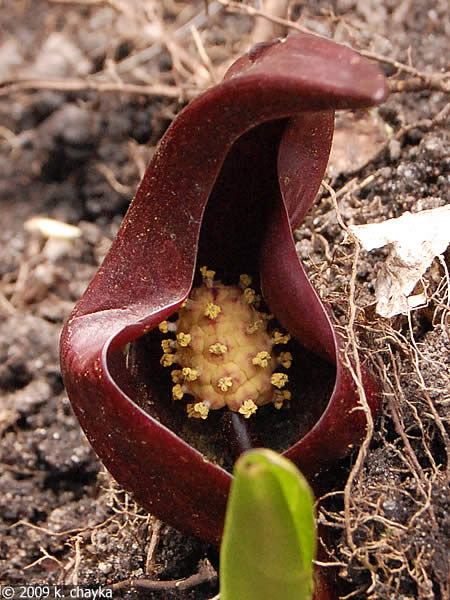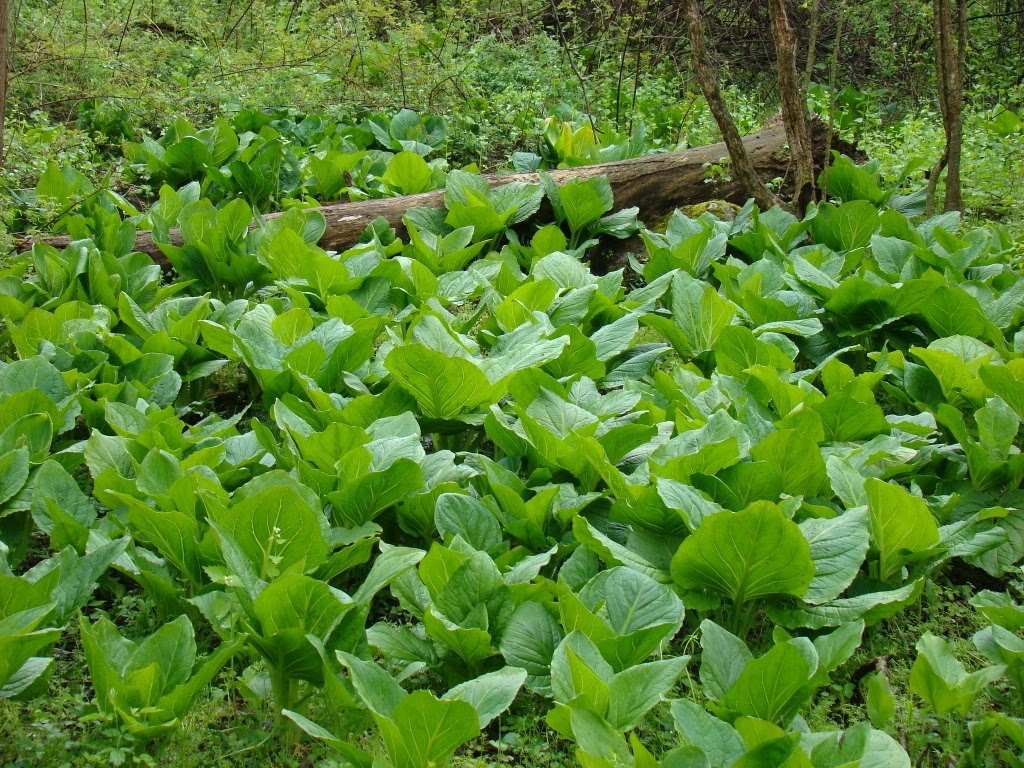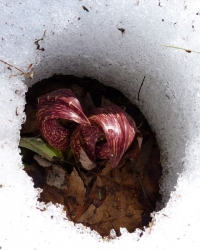Description

Skunk cabbage (Symplocarpus foetidus) flowers emerge from the ground in early spring before the leaves. The whole plant generates heat through cyanide-free cellular repiration (whatever that means!), making it one of the few plants capable of this "thermogenesis".
The plants can produce temperatures of 15-35 degrees C (55-95 F) allowing them to grow through frozen ground. The heat may also help them spread the odor of their flowers and attract early spring pollinators which come to eat and take refuge in the flower structure.
The "flowers" actually consist of a spathe and a spadix. A spathe is a modified leaf which looks like a hood. The spathe surrounds a spadix, a cylindric structure which contains a bunch of tiny flowers packed together.
Eastern skunk cabbage spathes are 10-15cm (4-6 in) and range in color from mottled maroon and yellow to solid maroon, while spadices are 5-10cm (2-5 in) and can be pure yellow or dark purple. The leaves are impressively large, 40–55 cm (15.75-21.5 in) long and 30–40 cm (12-15.75 in) wide. They are arranged in a basal rosette which simply means that the leaves are born in a circle around a central stem which does not grow higher than ground level.
The plants are ephemeral. That is, their leaves die by late summer and the plants go dormant until the following spring. After being pollinated the flowers produce a large 10cm (4inch) tall by 1cm (1/3 inch) wide, purple or black, compound fruit which ripens as or soon after the rest of the plant has gone dormant. Like the flowers, the fruit becomes smelly as it matures.
Underground the plant has a large central root about 30 cm (1 foot long) by about 7 1/2 -15 cm (3-6 inches) wide. The main root is surrounded by a large mass of fibrous roots. Each year the roots contract and pull the plant deeper into the ground making it almost impossible to dig up.
Range
Eastern skunk cabbage is a boreal species found in both North America and Asia. Some botanists consider the Symplocarpus found in northeast China, Siberia, and Japan a separate species (or several species). Either way they are closely related, and our lineage is thought to have crossed the Bering Strait during one of the ice ages when sea level was lower and there was a land connection between North America and Asia. It is curiously absent between the west coast and Minnesota (considering it migrated from Asia). It ranges from Minnesota and Northern Ontario to the east coast of the USA and Canada and as far south as Tennessee and North Carolina. Another genus of skunk cabbage, Lysichiton, has several species and is found in the Western United States and Asia.

Habitat and Cultivation
Eastern skunk cabbage grows in wet mucky soil, along streams or springs, in woods, thickets, and bogs. It can even grow on hillsides but only if there is a continuous seepage of water. Skunk cabbage appears to be tolerant of soil ranging from slightly acidic to slightly alkaline. This truly striking, bizarre, and fascinating plant would make an exciting addition to any garden that has the right conditions. The plant can be purchased from a small handful of specialty nurseries or grown from freshly collected seeds (with permission from the landowner where the parent plants are growing) that are not allowed to dry out. Skunk cabbage needs a wet shady spot and tolerates shallow standing water but only if it is not permanent and soaks in the soil or evaporates over time.
Wildlife Use
The leaves of eastern skunk cabbage are food for snails and slugs as well as ruby tiger moth (Phragmatobia fulginosa) and cattail borer moth (Bellura obliqua) caterpillars. Although the leaves contain crystals of calcium oxalate, making them toxic to most animals, hungry snapping turtles and bears have been observed eating the leaves in spring. Gnats, carrion flies (Calliphoridae), and flesh flies (Sarcophagidae) pollinate the flowers which they are attracted to due to their flesh-like smell and appearance as well as the warm temperatures generated by and sustained within the spathe. Not surprisingly, spiders like to live in skunk cabbage flowers where they await unsuspecting pollinators. (Wildlife information from www.illinoiswildflowers.info)
Cultural Value
Eastern skunk cabbage roots were cooked and eaten by some Native American tribes. Various parts of the plant were prepared in lots of different ways (depending on the symptom, wound, or infection) to treat conditions ranging from headache, earache, bleeding, to skin and mouth sores etc. Because the leaves, stems, and flowers are toxic, use of this plant without oversight from a trained physician with extensive herbal experience is not advised!
Conservation
Skunk cabbage is still relatively common but only in undisturbed older woods and bogs. It is a conservative species that does not bounce back from deforestation or changes in water levels that often accompany agriculture and development. Protecting the habitat of this and other sensitive plants and animals is of great importance.





